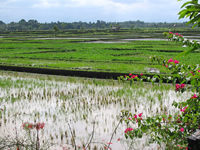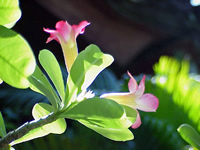 Bali is an amazingly fertile and beautiful island. Nature has combined to offer a place with high mountain lakes, jungle, a selection of climates and wildlife. The southern section of Bali is very fertile and Tabanan district in the SW is where most of the rice is grown. NW and NE Bali tends to be very dry with a dry scrub landscape. The Bukit peninsula in the far south is a limestone plateau that is unsuitable for rice growing, local people resorting to cattle and corn. Inside the Batur crater in the NW section one will find lava fields, the area around Gunung Batukaru jungle and bamboo forests elsewhere on the island. In higher elevations crops such as coffee, cocoa and vanilla are grown, remnants of the Dutch occupation.
Bali is an amazingly fertile and beautiful island. Nature has combined to offer a place with high mountain lakes, jungle, a selection of climates and wildlife. The southern section of Bali is very fertile and Tabanan district in the SW is where most of the rice is grown. NW and NE Bali tends to be very dry with a dry scrub landscape. The Bukit peninsula in the far south is a limestone plateau that is unsuitable for rice growing, local people resorting to cattle and corn. Inside the Batur crater in the NW section one will find lava fields, the area around Gunung Batukaru jungle and bamboo forests elsewhere on the island. In higher elevations crops such as coffee, cocoa and vanilla are grown, remnants of the Dutch occupation.
Dr. Lawrence Blair, who with his brother Lorne filmed the Ring Of Fire documentary, said that nowhere else does man live in such harmony with nature. After visiting other islands in Indonesia, he was struck by how well the Bali people and their culture, blend with the sculptured rice terraces.
One can argue about the effects of rice fields themselves on the eco-system. In some respects the rice fields have altered the eco-system and created another. Flat trays of still freshwater getting baked in the hot sun is definitely a unique environment. The rice-fields are home to frogs, which make a cacophony of sounds at night. Locals like to catch frogs (kodok) for food. The rice fields are also a breeding ground for worms, which the locals keep in check by herding large groups of ducks through. There is also a moth with white patches on its wings. Contact with this moth leaves a type of chemical burn on the skin. Balinese people often plants other things on the sections of land separating the rice fields and one can often see the ladies collecting flowers for ceremonies.
The rice fields look amazing, but the type of rice grown is not the same as a hundred years ago. Exotic varieties of rice have been imported, which have a higher output and this together with the use of fertilizers means Balinese farmers can expect high yields.
The problem is that the watercourses start to get polluted with the runs off from the chemicals. Burning the stalks left over from a rice harvest creates massive amounts of dense white smoke and ploughing the stalks back into the ground while the field is flooded creates enormous amounts of methane, due to the anaerobic respiration process underwater. This methane traps 4 times the amount of heat as CO2 when its reaches the upper atmosphere. Bali has 5,632 sq km and 3.1 million people, giving a population density of 559.2 per sq km. Most of the land in Bali is either developed for housing, shops, temples or agriculture. The largest section of undeveloped land is the Bali Barat National Park.
Bali was once connected to Java and virtually all the flora and fauna on the island came from elsewhere. There are a few incidences of local Balinese variety such as the wani, the giant size white mango. Still the island is quite young geologically and most species can be traced elsewhere.
Common trees found in Bali include the banyan tree, one of which will be next to every major temple. The waringin as the tree is called is referred to as the tree that never dies as its roots touch down to Earth from up above and start a new tree. Another common tree is the frangipani (jepun) with its white flowers.
Bali has 2 seasons, wet and dry, which means its monsoonal climate cannot support varieties of tropical hardwoods that need year round rainfall. Much of the quality wood used for carving and furniture comes from Java and Sulawesi. Local Balinese wood used for handicrafts includes jackfruit, with fast growing bamboo also easy to find.
 A trip around Bali which includes the coastal inland and highland areas will offer a multitude of plant varieties. Among the plants commonly found in Bali are champak, a variety of magnolia, angsoka with red-orange flowers, poinsettia, water lily, hibiscus, bougainvillea, jasmine, oleander. Orchids are found all over and come in a multitude of varieties. All this sounds great unless you are a hay fever sufferer, meaning the starts of the dry season will not be pleasant for you. For people planning to live in Bali who are interested in gardening, your problem won’t be getting things to grow, but keeping them in check. Evergreens drop leave continually and need constant attention. Bushes and trees can sprout up and reach 2 meters in no time at all, some displaying an almost indestructible nature. Stepping out into your on garden and picking a ripe papaya, or harvesting red chilis is definitely one of the advantages of living in Bali.
A trip around Bali which includes the coastal inland and highland areas will offer a multitude of plant varieties. Among the plants commonly found in Bali are champak, a variety of magnolia, angsoka with red-orange flowers, poinsettia, water lily, hibiscus, bougainvillea, jasmine, oleander. Orchids are found all over and come in a multitude of varieties. All this sounds great unless you are a hay fever sufferer, meaning the starts of the dry season will not be pleasant for you. For people planning to live in Bali who are interested in gardening, your problem won’t be getting things to grow, but keeping them in check. Evergreens drop leave continually and need constant attention. Bushes and trees can sprout up and reach 2 meters in no time at all, some displaying an almost indestructible nature. Stepping out into your on garden and picking a ripe papaya, or harvesting red chilis is definitely one of the advantages of living in Bali.